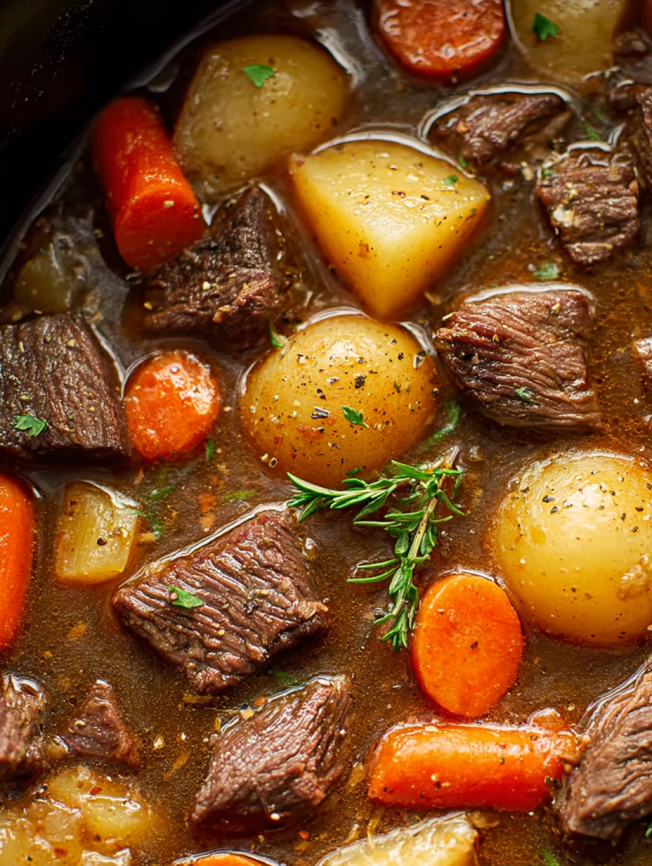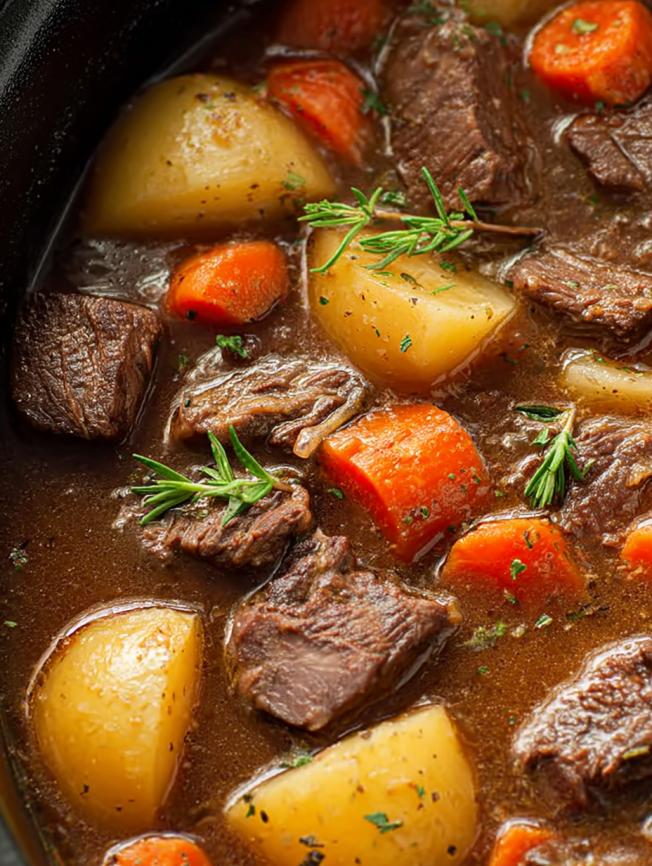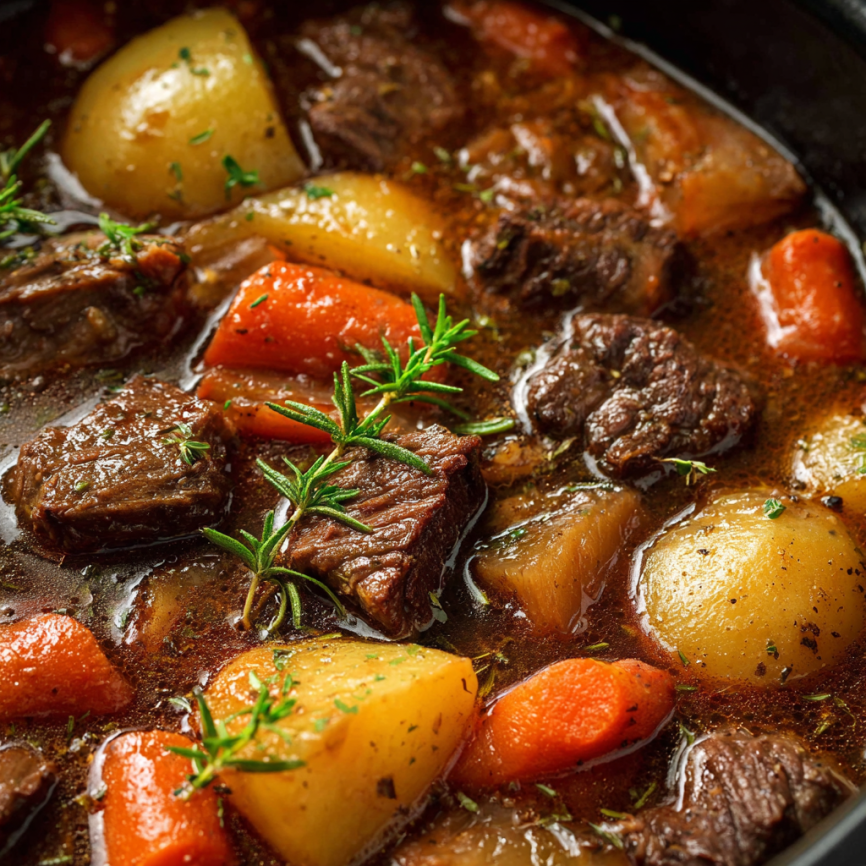Total Time: 8 hours | Prep Time: 15 minutes | Cook Time: 7-8 hours (low) or 4-5 hours (high) | Cuisine: American
There’s nothing quite like coming home after a long day to the incredible aroma of beef stew slowly simmering away in your kitchen. This recipe holds a special place in my heart because it reminds me of my grandmother’s Sunday dinners, when the whole house would fill with the rich, savory scents of beef and vegetables melding together into pure comfort. She taught me that the secret to exceptional stew wasn’t complicated techniques or exotic ingredients – it was simply time and patience.
What makes this slow cooker version so special is how it captures all those traditional flavors while fitting seamlessly into our modern, busy lives. The beauty of slow cooking lies in its simplicity: you do a bit of prep work in the morning, and by evening, you’re rewarded with a meal that tastes like it’s been lovingly tended all day.
This isn’t just any beef stew – it’s the kind that fills your soul and brings families together around the dinner table. Moreover, it’s incredibly forgiving, making it perfect for both seasoned cooks and kitchen beginners who want to create something truly memorable.
Why You’ll Love This Slow Cooker Beef Stew
Set-and-Forget Convenience The greatest advantage of this recipe is its hands-off approach. Once you’ve done the initial prep and searing, your slow cooker does all the heavy lifting. This means you can start it before work and come home to a completely finished, restaurant-quality meal waiting for you.
Melt-in-Your-Mouth Tender Beef Chuck roast transforms into incredibly tender, fork-soft pieces through the magic of slow cooking. The long, gentle cooking process breaks down tough connective tissues, resulting in beef so tender it practically falls apart at the touch of a fork.
Deep, Complex Flavors Unlike quick-cooking stews, this slow-cooked version allows all the flavors to develop and intensify over hours. The beef releases its rich juices, vegetables contribute their natural sweetness, and the herbs and spices create layers of complexity that simply can’t be rushed.
Budget-Friendly Family Meal Chuck roast is one of the most economical cuts of beef, yet when slow-cooked properly, it rivals much more expensive cuts in flavor and texture. Additionally, this recipe stretches to feed a large family or provides multiple meals’ worth of leftovers.
Perfect for Meal Prep This stew actually improves with time, making it ideal for meal prepping. The flavors continue to develop in the refrigerator, and it freezes beautifully for up to three months.
Ingredients You’ll Need
The Protein Foundation
- Beef Chuck Roast (2 lbs, cut into bite-sized pieces) – The star ingredient that becomes incredibly tender and flavorful through slow cooking
- Olive Oil (2 tbsp) – Essential for searing the beef and building that crucial flavor base
Aromatic Base
- Onion (1 large, diced) – Provides sweet, savory depth that forms the flavor foundation
- Garlic (3 cloves, minced) – Adds aromatic complexity and enhances the overall flavor profile
Hearty Vegetables
- Carrots (3, chopped) – Contributing natural sweetness and vibrant color while holding their shape beautifully
- Potatoes (3 medium, diced) – Creating substance and helping to naturally thicken the stew
- Celery (2 stalks, chopped) – Adding crisp texture and subtle flavor that rounds out the vegetable medley
Flavor Builders
- Tomato Paste (2 tbsp) – Concentrated tomato flavor that adds richness and depth
- Worcestershire Sauce (1 tbsp) – Secret ingredient that provides umami complexity and enhances the meaty flavors
- Beef Broth (4 cups) – The liquid foundation that becomes a rich, flavorful sauce
- Diced Tomatoes (1 can, 14 oz) – Adding acidity and additional tomato flavor that brightens the stew
Seasoning Blend
- Bay Leaf (1) – Infuses the entire stew with subtle herbal notes
- Thyme (1 tsp, dried) – Classic herb that complements beef beautifully
- Paprika (1 tsp) – Provides mild warmth and beautiful color
- Salt & Pepper (to taste) – Essential seasonings that bring all flavors into harmony
Optional Thickening Agent
- Cornstarch (2 tbsp, mixed with ¼ cup water) – For those who prefer a thicker, more substantial stew consistency
Step-by-Step Instructions
Building the Flavor Foundation
Step 1: Master the Searing Technique Heat the olive oil in a large skillet over medium-high heat until it shimmers and is nearly smoking. Pat the beef pieces completely dry with paper towels – this is crucial for achieving a proper sear. Season the beef generously with salt and pepper.
Working in batches to avoid overcrowding, sear the beef pieces for 2-3 minutes per side until they develop a rich, golden-brown crust. Don’t move them too quickly; let them develop that beautiful caramelization which adds incredible depth to the final stew. Transfer the seared beef directly to your slow cooker, including any accumulated juices.
Creating the Perfect Vegetable Medley
Step 2: Layer the Vegetables and Seasonings Add the diced onions, chopped carrots, diced potatoes, chopped celery, and minced garlic to the slow cooker with the seared beef. The vegetables will release moisture during cooking, so don’t worry if the slow cooker looks quite full at this point.
Next, add the tomato paste and Worcestershire sauce, distributing them evenly throughout the mixture. Pour in the beef broth and diced tomatoes with their juices, ensuring the liquid covers most of the ingredients. Add the bay leaf, dried thyme, paprika, and season generously with salt and pepper.
The Slow Cooking Magic
Step 3: Set It and Forget It Give everything a gentle stir to combine the ingredients, then cover the slow cooker with its lid. For the most tender results, cook on low heat for 7-8 hours. If you’re short on time, you can cook on high heat for 4-5 hours, though the low and slow method yields superior texture and flavor development.
During cooking, resist the temptation to lift the lid frequently, as this releases heat and extends cooking time. The beauty of slow cooking lies in its hands-off approach.
Final Touches and Serving
Step 4: Optional Thickening Process About 20 minutes before serving, check the stew’s consistency. If you prefer a thicker stew, mix the cornstarch with cold water until smooth, creating a slurry. Stir this mixture into the slow cooker and continue cooking on high for 15-20 minutes until the stew reaches your desired thickness.
Step 5: Perfect the Final Seasoning Remove and discard the bay leaf. Taste the stew and adjust the seasoning with additional salt and pepper as needed. The flavors should be rich, well-balanced, and deeply satisfying.

Serving Suggestions
Classic Comfort Pairings
This robust stew pairs magnificently with crusty artisan bread or warm dinner rolls, perfect for soaking up every drop of the flavorful broth. Alternatively, serve over fluffy white rice or creamy mashed potatoes for an even more substantial meal.
Elegant Presentation Ideas
For special occasions, serve the stew in individual bread bowls or over buttery egg noodles. Garnish with fresh chopped parsley or thyme for a pop of color and freshness that elevates the presentation.
Family-Style Serving
Present the stew in a large, rustic serving bowl at the center of the table, allowing family members to serve themselves. Provide small bowls of shredded cheese, fresh herbs, or crusty bread on the side for customization.
Recipe Variations
Hearty Root Vegetable Version
Enhance the earthiness by adding parsnips, turnips, or sweet potatoes along with the traditional vegetables. These additions provide different textures and subtle flavor variations that make the stew even more interesting.
Red Wine Enhanced Stew
Replace one cup of beef broth with dry red wine for a more sophisticated flavor profile. The wine adds depth and richness that pairs beautifully with the beef. Add the wine after searing the beef and let it simmer briefly before adding to the slow cooker.
Mushroom Lover’s Variation
Add 8 ounces of sliced cremini or button mushrooms for an extra umami boost. The mushrooms contribute earthiness and help create an even richer broth. Add them with the other vegetables at the beginning of cooking.
Herb-Crusted Version
Create an herb blend using fresh rosemary, sage, and additional thyme. Add these herbs during the last hour of cooking to preserve their bright flavors while still allowing them to infuse the stew.
Spicy Southwest Twist
Transform this classic into a southwestern-inspired dish by adding diced green chiles, cumin, and a touch of chili powder. Serve with cornbread and topped with fresh cilantro for a completely different but equally delicious meal.
Make-Ahead Tips
Advanced Preparation Strategies
This stew is ideal for meal planning and can be prepared in several ways to save time. Cut all vegetables and beef the night before, storing them separately in the refrigerator. In the morning, simply sear the beef and add everything to the slow cooker.
Freezer-Friendly Options
The complete stew freezes beautifully for up to three months. Cool completely before transferring to freezer-safe containers, leaving some room for expansion. Thaw overnight in the refrigerator before reheating gently on the stovetop.
Batch Cooking Benefits
Double the recipe and freeze half for future meals. This approach saves both time and money while ensuring you always have a comforting meal ready when needed. The flavors actually improve after freezing and thawing.
Reheating Guidelines
When reheating, add a splash of beef broth if the stew seems too thick. Heat slowly over medium-low heat, stirring occasionally, until warmed through. Avoid rapid reheating, which can make the beef tough.
Professional Tips & Notes
- Meat Selection Matters: Chuck roast is ideal because its marbling and connective tissue break down beautifully during slow cooking, creating incredibly tender results. Avoid lean cuts which will become dry and tough.
- Searing is Non-Negotiable: Don’t skip the searing step, even though it adds time. This process creates complex flavors through the Maillard reaction that can’t be replicated any other way.
- Vegetable Timing: Root vegetables like carrots and potatoes hold up well to long cooking times. If adding delicate vegetables like peas or green beans, stir them in during the final 30 minutes.
- Liquid Level Management: Ensure there’s enough liquid to cover the ingredients, but don’t overfill. The vegetables will release moisture as they cook, and you don’t want the stew to become too thin.
- Temperature Safety: Always ensure the beef reaches an internal temperature of at least 160°F for food safety, though slow cooking typically far exceeds this temperature.

Frequently Asked Questions
Can I use a different cut of beef?
While chuck roast is ideal, you can substitute with other tough, marbled cuts like beef short ribs or bottom round. Avoid lean cuts like sirloin or tenderloin, as they’ll become dry and tough during the long cooking process. The key is choosing cuts with enough fat and connective tissue to break down during slow cooking.
What if I don’t have time to sear the beef?
While searing significantly improves flavor, you can skip this step in a pinch. Add an extra tablespoon of tomato paste and consider browning the beef in the slow cooker on the sauté setting if your model has this feature. The result won’t be quite as rich, but it will still be delicious.
How can I make this stew thicker without cornstarch?
Several natural thickening methods work well. Mash a few pieces of potato against the side of the slow cooker and stir them in, or add a handful of quick-cooking oats during the last hour. You can also remove some vegetables, blend them until smooth, and stir the puree back into the stew.
Can I add wine to this recipe?
Absolutely! Replace up to one cup of beef broth with dry red wine for added depth. Add the wine after searing the beef and let it simmer for 2-3 minutes to cook off the alcohol before adding to the slow cooker. Choose a wine you’d be happy drinking, as the flavor will concentrate during cooking.
Why is my stew meat still tough?
Tough meat usually indicates insufficient cooking time or temperature. Chuck roast needs the full cooking time to break down properly. If using the high setting, consider switching to low for the remaining time. Also, ensure you’re using a marbled cut rather than a lean one.
How do I prevent vegetables from becoming mushy?
Cut root vegetables into larger pieces, as they’ll shrink during cooking. Add delicate vegetables like peas or green beans during the final 30 minutes. If your vegetables consistently overcook, try layering them on top rather than stirring them in, as the bottom of the slow cooker runs hotter.
Can I make this recipe in a regular pot instead?
Yes! Use a heavy Dutch oven and simmer on the stovetop over low heat for 2-3 hours, or cook in a 325°F oven for the same time. Check periodically and add more broth if needed. The slow cooker method is more convenient, but stovetop cooking works well too.
How long will leftovers keep?
Properly stored leftovers will keep in the refrigerator for up to 4 days. The stew often tastes even better the next day as the flavors continue to develop. It also freezes well for up to 3 months, though the potatoes may change texture slightly after freezing.

